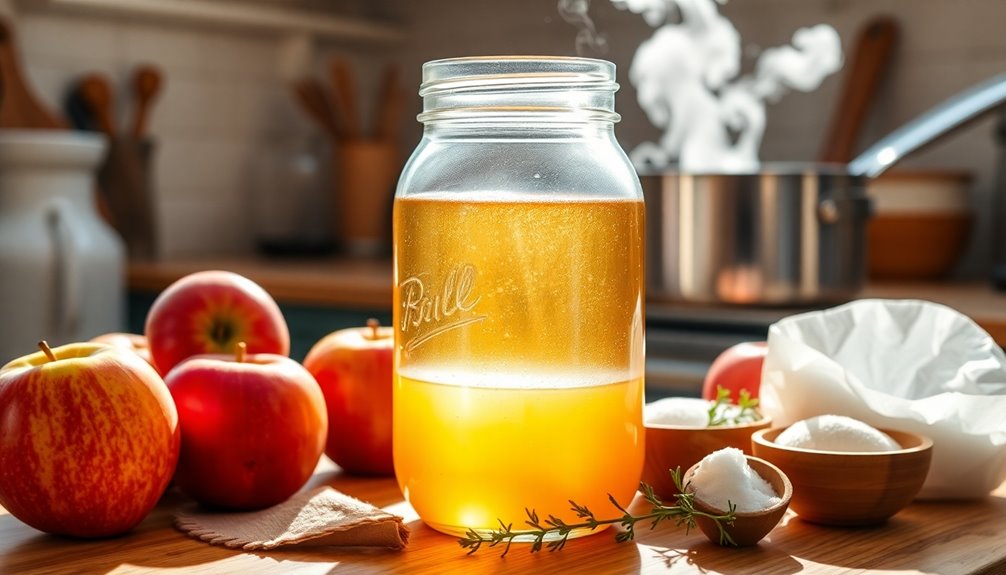You can easily turn fresh apple juice into delicious homemade apple cider vinegar. Start by picking ripe apples and extracting their juice. Ferment the juice using yeast, allowing it to transform sugars into alcohol over three to four weeks. Then, introduce acetic acid bacteria for the vinegar process. Remember to taste along the way and adjust flavors. If you want to explore health benefits and creative uses, there's plenty more to discover!
Key Takeaways
- Start with fresh, raw apple juice from ripe, organic apples for optimal fermentation results.
- Ferment the juice using yeast for 3-4 weeks, then allow acetic acid bacteria to convert alcohol into vinegar.
- Maintain a temperature between 60°F and 80°F and stir daily during secondary fermentation for proper oxygen supply.
- Regularly taste your vinegar to monitor flavor development, aiming for acidity levels around 4.8%.
- Store finished vinegar in a cool, dark place in airtight containers for long-lasting quality.
Essential Ingredients and Equipment
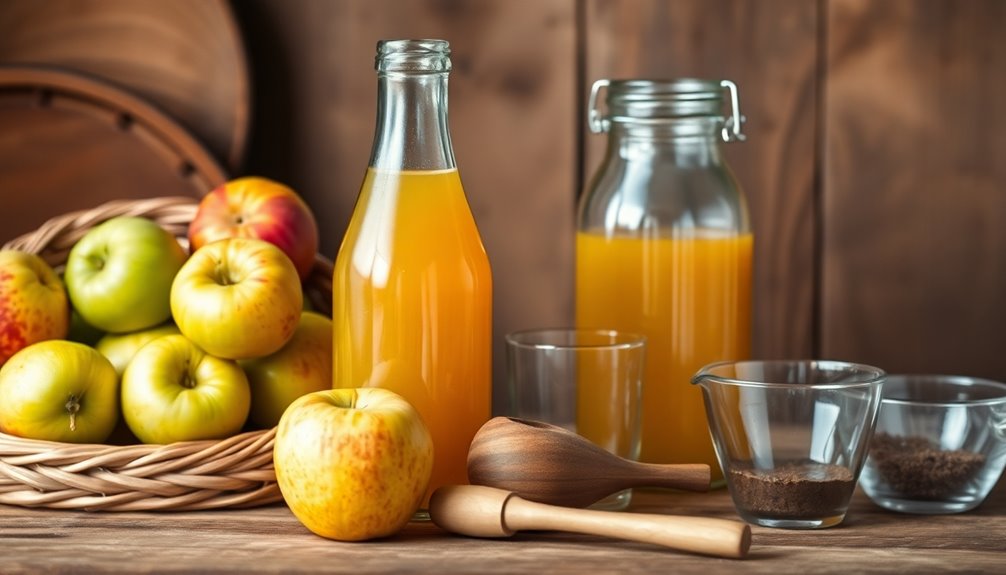
When you're ready to make your own apple cider vinegar, you'll need to gather some essential ingredients and equipment.
Start with fresh, raw apple juice, as it’s best for fermentation. If you use store-bought juice, you might need additional yeast due to pasteurization. Yeast is crucial for converting the sugars into alcohol, while the vinegar mother contains the necessary bacteria to turn that alcohol into vinegar. Additionally, this fermentation process typically involves two phases, with the first phase focusing on yeast activity. During the first phase, the yeast ferments the sugars in the apple juice, producing alcohol and carbon dioxide. Once this initial fermentation is complete, you can introduce the vinegar mother to facilitate the transformation of alcohol into vinegar during the second phase. With the right ingredients and conditions, you can brew alcohol from juice easily, creating a delicious base for homemade vinegar that enhances your culinary creations.
You may also want to add water if your juice is too concentrated.
For equipment, a wide-mouthed glass fermentation jar is ideal, along with a cloth cover to keep contaminants out. Don't forget bottles, a funnel for transferring, and cheesecloth or a filter for straining your finished product.
Happy brewing!
Preparing Your Apple Juice
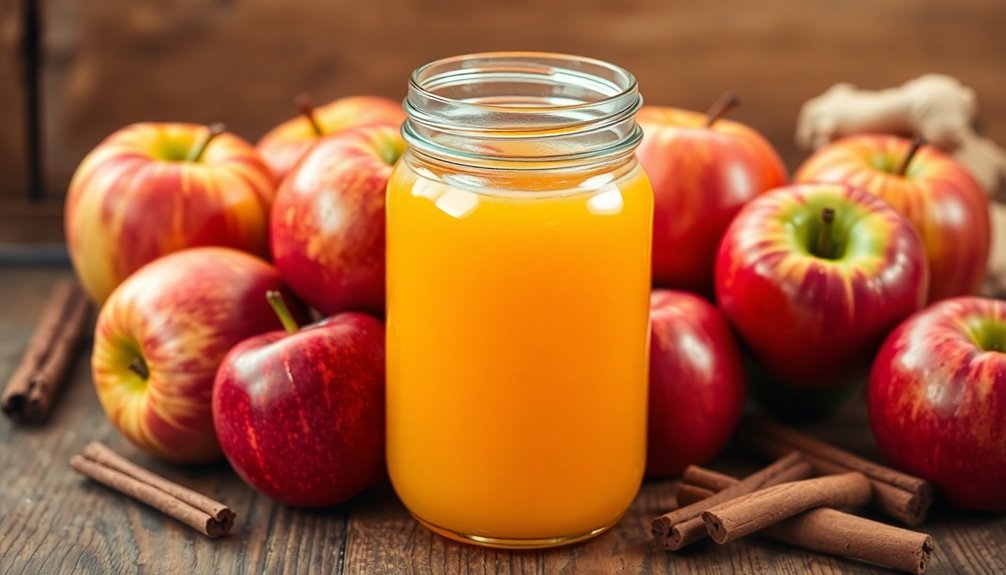
To prepare your apple juice for vinegar production, start by selecting fresh, ripe apples that offer a balance of sweetness and tartness. Mix different apple varieties for a more complex flavor, and avoid any with signs of rot or mold. Once you have your apples, wash them thoroughly to remove dirt and wax. Remove the stems and leaves, as they can add bitterness, and core the apples to eliminate seeds. You can choose to peel them, but keep in mind that the peels can enhance color and flavor. For juice extraction, blend with a little water, boil until soft, or use a juicer. Make sure the juice is free from pulp and sediment before storing it in a cool, dark place. Additionally, using sweet apple varieties will enhance the flavor of your juice significantly. Organic fruits and vegetables are often recommended for juicing to avoid pesticides that may affect the quality of your juice.
The Fermentation Process Explained
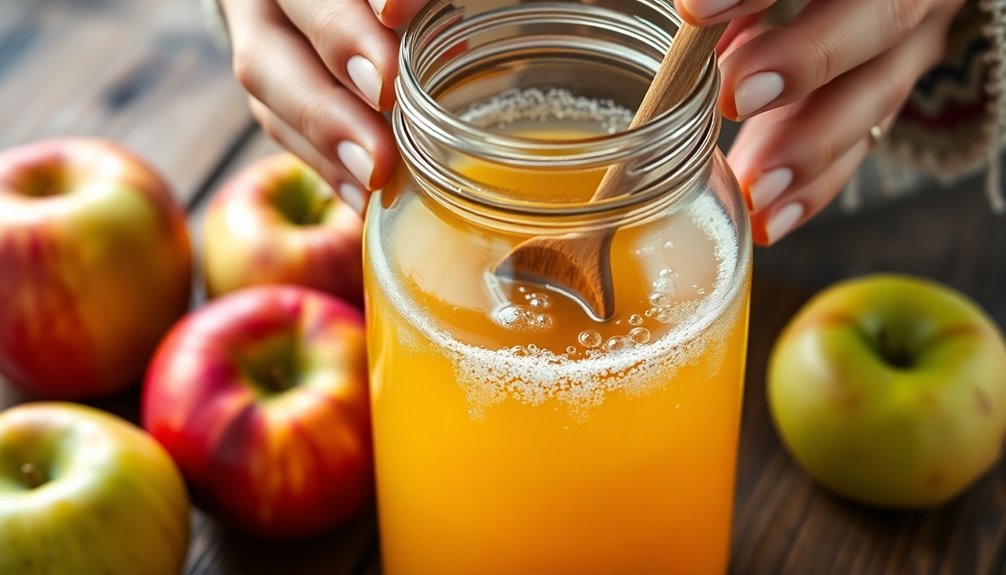
Understanding the fermentation process is essential for transforming your apple juice into delicious apple cider vinegar. It begins with initial fermentation, where yeast converts sugars in your juice into alcohol. You can add yeast to speed things up, but natural fermentation can occur if conditions are right, typically taking 3 to 4 weeks.
Next comes secondary fermentation, where acetic acid bacteria convert alcohol into acetic acid, requiring oxygen. This phase is slower, and you'll notice the vinegar smell intensifying. Daily stirring is crucial during this phase to ensure proper oxygen supply.
Keep an eye on acidity levels, aiming for around 4.8%. Ensure your fermentation environment is optimal, with temperatures between 60°F and 80°F, away from direct sunlight, and allow air exchange by not sealing your container tightly.
Health Benefits of Homemade Apple Cider Vinegar
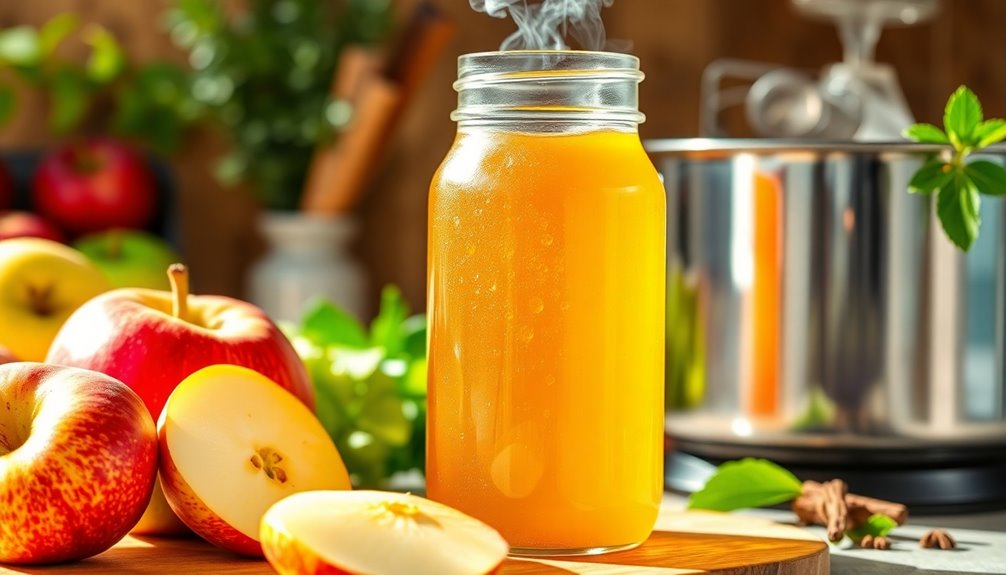
Homemade apple cider vinegar offers a range of impressive health benefits that can enhance your well-being. It can aid in weight management by increasing feelings of fullness, helping you reduce calorie intake. If you're looking to manage blood sugar levels, particularly if you have Type 2 diabetes, this vinegar can be beneficial. Additionally, its ability to kill harmful bacteria makes it a great option for supporting your overall immune health. It also shows promise in lowering cholesterol levels and improving insulin sensitivity. Furthermore, its role in diversification of investments can inspire a holistic approach to health and finances. Plus, its antimicrobial properties can support digestive health and boost your immune system with its antioxidant content.
Troubleshooting Common Issues
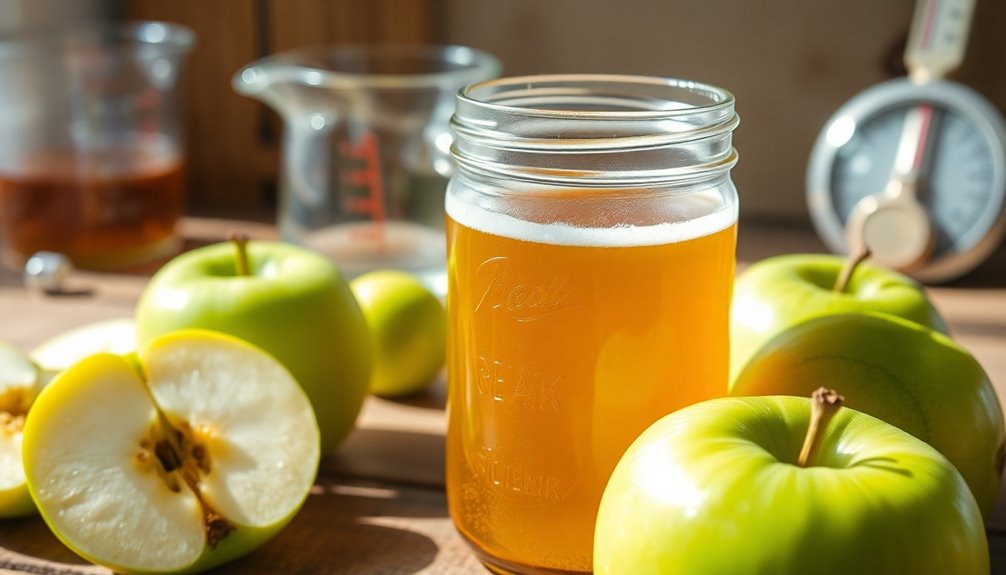
When you embark on making apple cider vinegar, it's common to encounter a few issues during the fermentation process.
Mold growth can occur if apple scraps aren't fully submerged; using a fermenting weight helps. If you notice a film forming, it's usually normal, but skim it off if it gets excessive and continue fermentation. Making raw apple cider vinegar at home is easy and cost-effective, which can help alleviate some concerns about the fermentation process. Regular maintenance of your fermentation setup ensures optimal conditions for fermentation.
Slow fermentation can happen due to temperature fluctuations—aim for a consistent 70°F to 75°F. Contamination is another risk, so always use clean, sterilized equipment and avoid chlorinated water.
Cover your jar with breathable materials like coffee filters to keep insects out while allowing air exchange.
Creative Uses for Apple Cider Vinegar
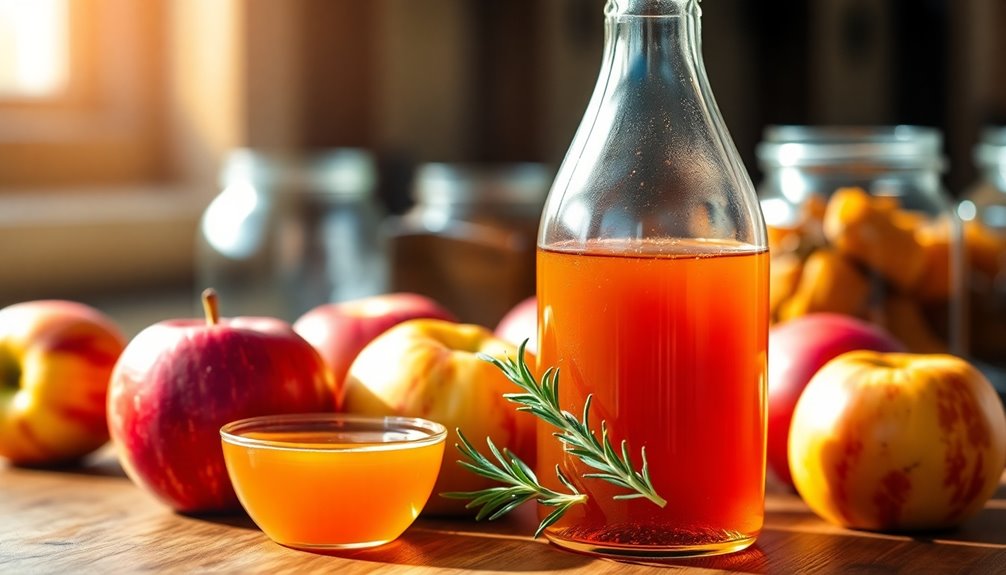
Apple cider vinegar isn't just for making tangy salad dressings; it boasts a variety of creative uses that can enhance both your cooking and personal care routines.
You can elevate your marinades and sauces with its vibrant flavor or use it for quick pickling, giving vegetables a unique taste. In baking, it adds tenderness and helps your cakes rise. Additionally, using apple cider and/or juice can provide a robust base for homemade vinegar that enhances these culinary creations. For health benefits, try it in immunity shots or as a digestive aid, and consider incorporating essential oils for toothache relief for added wellness benefits.
As a beauty product, it serves as a skin toner, balancing pH and reducing acne. You can also use it as a natural cleaner for your home or a deodorizer for your feet.
With so many options, apple cider vinegar deserves a spot in your pantry and bathroom!
Cost and Environmental Impact
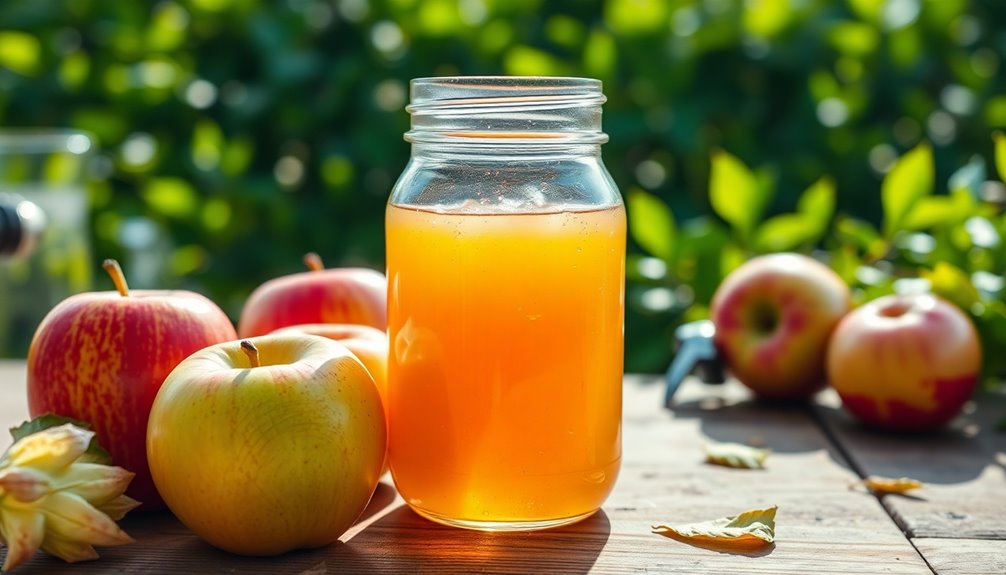
Making apple cider vinegar at home is often cheaper than buying it in stores, especially if you have access to inexpensive apples or apple juice. By utilizing apple scraps, you reduce waste and save money while creating something beneficial. Additionally, the process of making vinegar takes only 5 minutes, making it a quick and easy option for those looking to be more sustainable in their kitchen practices. Advanced cleaning features of homemade vinegar can enhance the hygiene of your cooking environment. Homemade production also has a lower carbon footprint since it requires minimal energy and reduces transportation needs. You can further lessen your environmental impact by storing your vinegar in reusable containers.
Tips for Flavor Experimentation
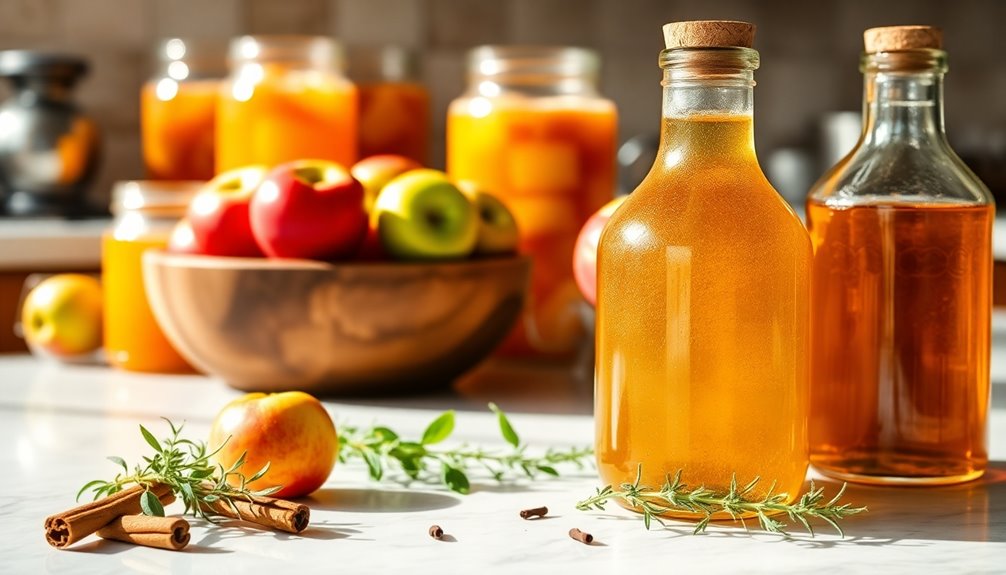
Crafting your own apple cider vinegar opens the door to a world of flavor experimentation. Start by mixing different apple varieties; each adds its unique twist. Consider infusing your vinegar with spices like cinnamon or herbs like bay leaves during fermentation for an aromatic touch. You might also try blending apple juice with other fruit juices, such as pear or blackcurrant, to create complex flavors. Remember, the aging process enhances richness, so don't rush it. Keep an eye on sugar content, as it affects acidity and sweetness. The fermentation process involves converting sugar into alcohol, which then turns into vinegar. Choose the right yeast and maintain a consistent fermentation temperature between 60°F and 80°F for optimal results. Regular taste testing will help you perfect your vinegar's flavor profile. Incorporating fermented vegetables can also inspire new flavor combinations in your culinary creations.
Frequently Asked Questions
Can I Use Store-Bought Apple Juice for Fermentation?
Yes, you can use store-bought apple juice for fermentation, but make sure it's preservative-free.
Pasteurized juice might hinder the fermentation process, so adding yeast can help kickstart it.
Keep in mind that the sugar content in commercial juices can affect your final product.
Monitor the fermentation closely and remember to taste regularly to achieve the acidity you prefer.
Using a vinegar mother will also enhance the conversion to vinegar.
How Do I Know When My Vinegar Is Ready?
You're eager to know when your vinegar's ready, but patience is key!
Watch for the smell to shift from alcohol to that distinct acidic tang. Bubbles will dwindle, hinting that fermentation's winding down.
Taste it; when it meets your preference, you're close! If a gelatinous "mother" appears, it's a good sign.
Ultimately, clarity and a well-rounded flavor indicate it's time to filter and bottle your creation.
Enjoy the process!
What Should I Do if My Vinegar Smells Bad?
If your vinegar smells bad, first check for contamination or over-fermentation.
You might need to re-ferment it with a fresh "mother" to restore balance.
Consider diluting the vinegar with water to lessen the smell.
Filtering can help remove any sediment causing issues.
Adding herbs or spices might mask unpleasant odors, but if the smell persists, it's best to discard it and start fresh with clean equipment and quality ingredients.
Is It Safe to Consume Homemade Apple Cider Vinegar?
Homemade apple cider vinegar can be a culinary treasure, but safety isn't guaranteed!
It's generally safe if you follow proper preparation and storage practices. Be cautious with acidity levels and avoid consuming it undiluted, as that can lead to digestive issues or tooth enamel erosion.
Always use clean equipment and fresh ingredients. If you pay attention to these factors, you can enjoy the benefits without worry!
Can I Reuse the Mother of Vinegar Multiple Times?
Yes, you can reuse the mother of vinegar multiple times!
Just rinse it well and store it submerged in vinegar within an airtight container. This practice speeds up fermentation and keeps your flavors consistent.
Ensure you refresh the vinegar every few months to maintain its health. If you notice any issues, like mold, it's best to discard it.
Conclusion
Now that you've unlocked the secrets of making apple cider vinegar, you're ready to dive into a world of tangy goodness. Picture your kitchen transformed into a bubbling cauldron of health and flavor, where every drop of your homemade elixir adds a splash of vitality to your meals. Embrace the journey of experimentation, letting your creativity flow like the golden liquid itself. With each batch, you're not just crafting vinegar; you're brewing a potion of wellness and delight!
Cindy thoroughly researches juicing trends, techniques, and recipes to provide readers with practical advice and inspiration. Her writing style is accessible, engaging, and designed to make complex concepts easy to understand. Cindy’s dedication to promoting the advantages of juicing shines through her work, empowering readers to make positive changes in their lives through the simple act of juicing.

